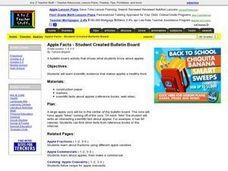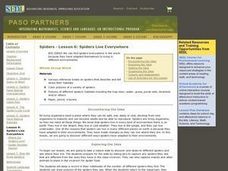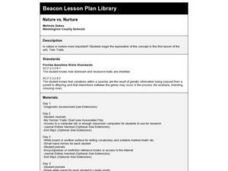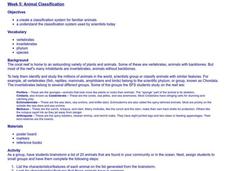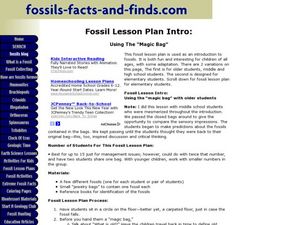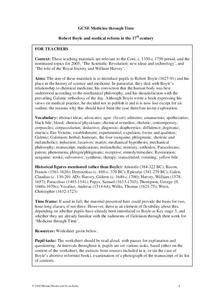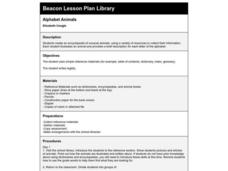Curated OER
Weather Watch
Students research severe weather conditions that occur in their region of the country and develop guidelines to deal with natural disaster-related emergencies.
Curated OER
Earth's History
Seventh graders study the law of superposition by creating models of fossils in layers of rock. They examine how fossils are usually found in sedimentary rock which leads to the study of geologic history in those rocks.
Curated OER
Waltz Across Texas
Seventh graders conduct research about regions of Texas by using the web. They research an endangered plant AND an endangered animal that is found in their region. Students prepare and deliver oral reports about their region.
Curated OER
Respiratory System
Students identify the parts of the respiratory system and how they interact. They define vocabulary words and draw an outline of themselves and label the parts of the respiratory system. They distinguish between healthy and unhealthy...
Curated OER
Apple Facts - Student Created Bulletin Board
Students research the health benefits of apples and create a bulletin board showing the scientific facts they find.
Curated OER
Nature vs. Nurture
Eighth graders investigate the concept of nature versus nurture in human development through this series of lessons.
Curated OER
ACID RAIN
Eighth graders, in groups, take on the role of either Biologist, Chemist, Health Scientist, or Economist. They complete a webquest in which they must decide what to do about a problem concerning the effects of acid rain. They make a...
Curated OER
Deserts Around the World
Second graders explore the deserts around the world. They use a map and locate America on the map. Students discuss and identify the characteristics of deserts and differentiate the meanings of the word desert and dessert. Students...
Curated OER
Corals and Coral Reefs
Students label the continents, oceans, and seas on a provided world map and use it to determine where they would expect most of the world's coral reefs to be found based on provided information the teacher has read to them.
Curated OER
Animal Classification
Students list characteristics and features of animals found in their community. They then group the animals according to how they are similar and different and create names for each group. They then create a chart of their...
Curated OER
The Origins of Man
Young scholars learn about new technologies being used to update what is known about human evolution and migration. They then compare the new theories to the traditional knowledge.
Curated OER
Spider Activities, Experiments and Projects
Students examine seven spiders and put them into two or three groups based on their structural similarities. In groups, they create a cladogram proposing possible ancestral relationships. Students design an experiment related to their...
Curated OER
Failing Ecosystems: Haiti and the Caribbean
Ninth graders study the impact that climate has on the land. They discuss how deforestation leads to erosion and soil damage and how trees and vegetation help to stabilize the land. They draw a large map of the Caribbean and show Haiti...
Curated OER
Bivalve Biology
Students place clams into a beaker containing saltwater. They place a small drop of food coloring just above the shell. Students observe the movement of the food coloring. Clams are then placed into clean beakers of saltwater with 24...
Curated OER
Sea Scape
Pupils learn about and make models of coral reefs. In this reef ecosystem lesson, the class locates a number of coral reefs on a map. They learn how a coral reef is a balanced ecosystem that depends upon all of it's plant and animal...
Curated OER
Making a Model Lung
Students explain the parts of the body that are involved in breathing and explore lung function. In this model lung lesson students make a model of a lung then interpret and explain it.
Curated OER
Fossil Facts and Finds- Using the Magic Bag
Students investigate fossils. In this geology instructional activity, students study various types of fossils in rocks and identify the characteristics of the fossil. Students write a research paper on their fossil.
Curated OER
Optical Illusions
Students view, identify, and construct four optical illusions. In this optical illusions lesson plan, students are introduced to four types of optical illusions. They construct their own illusions.
Michael Hunter and Fiona Kisby
Robert Boyle and Medical Reform in the 17th Century
Introduce pupils to the work of Robert Boyle and his influence on medical practice through a series of informational texts and discussion questions.
Core Knowledge Foundation
Columbus Sailed the Ocean Blue
Young adventurers embark on a journey, setting sail along the blue ocean with Christopher Columbus. Teachers will find that this unit makes their lesson planning smooth sailing!
Curated OER
CEENBot Soccer
Students research the history and uses of the different elements in the periodic table. In this chemistry lesson, students explain the significance of an element's valence electrons. They create a multimedia presentation of an element...
Curated OER
Perception is Not Always Reality
Students view various types of illusions. Using one of the illusions, they try to determine how a scientist might explain them. They discover a t-illusion and use their own words to analyze them. In groups, they research a different...
Curated OER
Alphabet Animals
Second graders create an encyclopedia of unusual animals, using a variety of resources to collect their information. Each student illustrates an animal and provides a brief description for each letter of the alphabet. A very nice,...






